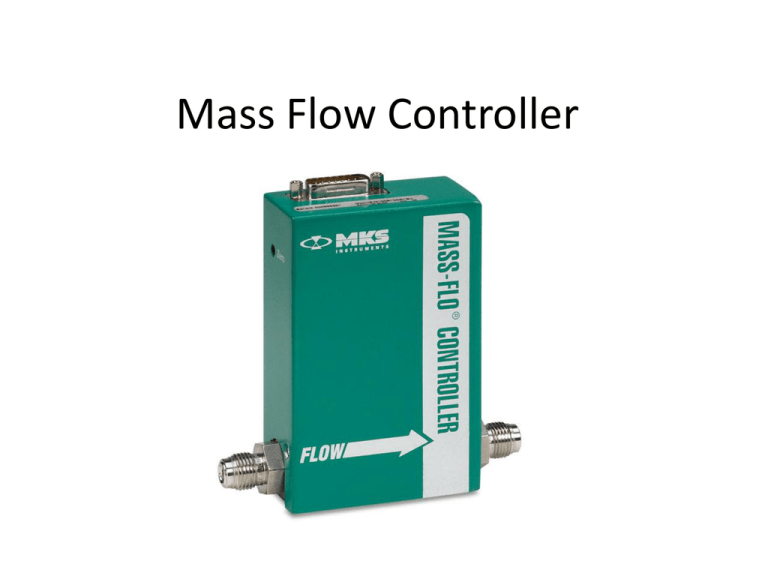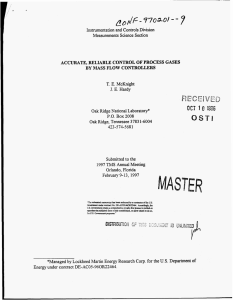MFC
advertisement

Mass Flow Controller Function • Delivers user specified flow rate of gas. • Flow rate is mass flow rate (i.e. number of molecules per sec Mol/sec), not volume flow rate (L/s). • It usually uses the unit of SCCM (stand cubic cm per minute). Theory of Operation On board circuit controller • Sensor measures flow rate • Valve adjusts size of opening • Controller adjusts valve opening until sensor senses that the actual flow rate is the same as the user set point Theory of Operation--control On board circuit controller • When the valve opens up 100%, the MFC reaches maximum flow rate. • The controller accepts a voltage value from the etcher computer controller that specifies the set point value of flow rate the user desires. • The set point is typically specified by the input signal as a percentage of the max flow rate of the MFC. For example if a MFC has a max flow of 100SCCM, and the input signal from the computer asks for 50% of the max, then the MFC will set the flow to 50SCCM. Theory of Operation--sensor • Sensor measures flow rate by measuring the lowering of temperature due to the cooling effect of gas flow. • How much flow rate reduces the temperature of the sensor by how much is related to the specific heat of the gas molecule. Thus flow rates measured by the sensor need to be calibrated for the specific gas used. MFC Gas Type Correction • Most MFCs coming from factories are calibrated for N2. You can multiple it by a correction factor for your specific gas to get the correct flow rate for you gas. That correction factor can be found in tables. • Say you have a 100sccm MFC. That means when its valve is 100% open, its flow rate = 100sccm (max flow) for the gas that the MFC is designated in the factory (typically N2). • Say if you want to use it for Phosphine, then find its correction factor in a table = 0.706. • Calculate the correct max flow of this MFC if you are to flow Phosphine through it as the following: • Max flow for Phosphine/max flow for N2 = Correction factor for Phosphine / correction factor for N2. • Max flow for Phosphine = Max flow for N2* (Correction factor for Phosphine/correction factor for N2) = 100*(0.706/1.000) = 70.6sccm • You have to enter this new max flow value in the configuration page of the etcher for that MFC. Theory of Operation--valve • Valve adjusts size of opening via solenoid, higher current lifts up the solenoid more. • Some MFCs can be installed only in a specific orientation to be accurate. Common MFC failure modes • • • • Zero point drift, potentiometer adjustment Leaks, leak check Blocked, cleaning External problems: input pressure too high, pressure differential between input and output too low or too high, power supply unstable, temperature fluctuation, etc. • Otherwise, replace MFC.











